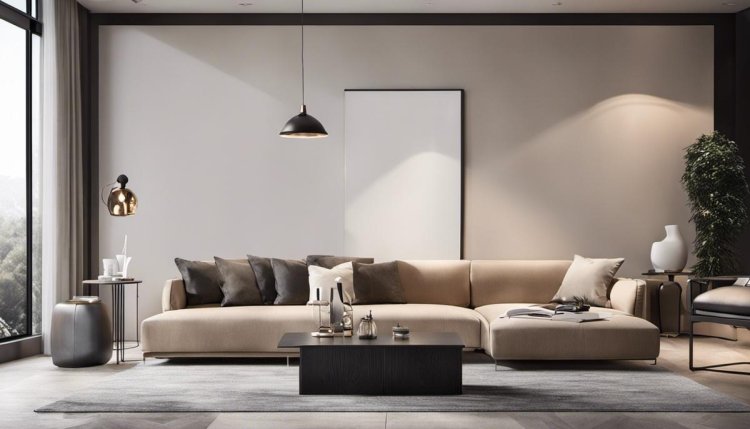Home space planning ideas
Discover practical and creative home space planning ideas to maximize the functionality and aesthetics of your living space.
Home space planning ideas
Dreaming about the perfect home is easier than actually creating it. But you don't have to despair! With the right tips and tricks, you can plan and create a great environment that reflects your personal style and needs. And best of all, you don't have to leave the comfort of your home!
In this article, you will find proven advice for planning the home space. From basic concepts to practical tips, everything you need to know is here. You can discover how to create the optimal layout of a room or how to maximize the use of space in your home. Whether you are a beginner or already have some experience with interior design, you will find useful advice and inspiration here.

The importance of planning the domestic space
Planning the home space is essential for creating a functional and aesthetic environment. It will allow you to make the most of the available space in your home and ensure that each room serves its purpose. Whether you have a small apartment or a spacious house, the right planning can turn any space into a comfortable and pleasant place.
When planning your home space, it's important to consider your lifestyle and the needs of your household. Think about how you use individual rooms and what activities take place in them. This will help you determine the layout and organization of the space.
In addition, home space planning allows you to incorporate your personal style and preferences. You can choose a design style and theme that reflects your taste and creates a cohesive look throughout your home. Thanks to this, your space will appear more harmonious and visually appealing.
Assessing your needs and goals
Before diving into the planning process, assessing your needs and goals for each room is essential. Spend some time thinking about how you use each space and what you want to achieve with it—looking for a cozy and relaxing living room? A functional and efficient kitchen? Or a quiet and comfortable bedroom?
Consider the activities that will take place in each room and the number of people who will use them. This will help you determine the size and arrangement of the furniture, as well as the storage and organizational solutions you will need.

It's also important to think about any specific requirements or issues you may have. For example, if you have pets or small children, you will need to consider their needs when planning your home space. Similarly, if you work from home or have a hobby that requires a dedicated space, be sure to set aside space for it.
Layout and Dimensions of your Home
In order to effectively plan your home space, you need to know the layout and dimensions of your home well. Take accurate measurements of each room, including height, width, and length. This will help you determine the scale of the furniture and make sure everything fits properly.
Consider the architectural features of your home, such as windows, doors, and built-ins. These can affect the placement of furniture and the flow of space. In addition, think about natural light and views in individual rooms. This will help you make the most of these elements when planning your home space.
Once you have a clear idea of the layout and dimensions, you can start creating the floor plan. There are many online tools and software available to help you visualize your ideas and experiment with different layouts. This allows you to see how everything fits together and make any adjustments before you make any physical changes to your space.

Choosing a design style and theme
Choosing a design style and theme is an important part of planning your home space. It sets the tone for your entire home and helps create a cohesive and visually appealing environment. There are many different design styles to choose from, from modern and minimalist to traditional and eclectic.
When choosing a design style, consider your personal preferences and the overall aesthetic you want to achieve. Look to magazines, websites and social networks like Pinterest or Instagram for inspiration. Create a mood board with images and colors that resonate with you and reflect the atmosphere you want to create in your home.
Once you've chosen a design style, it's important to stick to it throughout your home. This does not mean that every room has to look the same, but there should be a sense of continuity and harmony between them. Use similar colors, materials, and patterns to create a cohesive look that ties everything together.
Creating a budget for planning the space of your home
Creating a budget is a crucial step in planning the space of your home. It will help you prioritize your spending and ensure you stay within your means. Start by determining how much you can afford to spend on a home space planning project.
Consider all aspects that will require a financial investment, such as furniture, decorations, and any necessary renovations. Research the average cost of these items and services to get an idea of how much you'll need to budget for each.
It's also a good idea to set aside some extra cash for unexpected expenses or contingencies. This will give you peace of mind and allow you to handle any unforeseen issues that may arise during planning.

Once you have a budget, it's important to stick to it. Track your spending and adjust as needed to stick to the plan. Remember, creating a beautiful and functional home space doesn't have to break the bank. There are many affordable options and DIY projects to help you achieve your goals without breaking the bank.
Tips for choosing furniture and decorations
Choosing the right furniture and decorations is key to creating a well-planned and visually appealing home space. Here are some tips to help you make the right choice:
1. Consider the size and scale of the furniture in relation to the room. Avoid overcrowding and choose pieces that fit comfortably in the space.
2. If possible, choose multifunctional furniture. This will help maximize space utilization and provide additional storage options.
3. Combine different styles and textures to add visual interest to the space. Don't be afraid to experiment and add personal touches.
4. Consider the durability and maintenance requirements of the furniture and decorations. Choose materials that suit your lifestyle and are easy to clean and maintain.
5. Don't forget the importance of lighting. Invest in quality light fixtures and consider natural light sources in every room.
Remember that your furniture and decorations should not only look good but also serve their purpose. Think about how you will use each piece and whether it fits your lifestyle and needs.
Maximum use of storage space and organization
One of the key elements in home space planning is maximizing storage and organization. The right storage solutions will help you keep your home tidy and clutter-free, making it easier to maintain and enjoy. Start by assessing the storage needs of each room. Consider what items need to be stored and how often they are used. This will help you determine the type and size of storage solutions you will need.
Use all available space, including vertical and underutilized areas. Install shelves, hooks, and racks to maximize storage options. Consider investing in furniture with built-in storage, such as ottomans or beds with hidden compartments. Use organizational tools like bins, baskets, and drawer dividers to keep things organized.
Labeling and categorizing items will also make it easier for you to find what you need. Regularly declutter and reassess your storage needs. Get rid of things you no longer use or need and adjust your storage solutions as needed.

Incorporating functionality and personalization
When planning a home space, it is important to prioritize functionality and personalization. Your home should not only look good but also serve your needs and reflect your personality.
Think about how you will use the individual rooms and what activities will take place in them. Arrange furniture to promote ease of movement and accessibility. Consider the flow of the space and how the individual areas connect to each other.
Include personal items and items that have sentimental value. Display artwork, photographs, and other valuable items that reflect your interests and experiences. This will make your home look more pleasant and unique.
Don't forget the importance of comfort. Invest in quality sofas and bedding that provide sufficient support and promote relaxation. Consider acoustics and temperature control in each room to create a comfortable and welcoming environment.
Finding inspiration and resources
Finding inspiration and resources is essential when planning a home space. Fortunately, there are many resources available to help you get started and keep you inspired throughout the process.
Interior design magazines and books can provide valuable ideas and inspiration. Search for publications that match your style and design preferences. Online platforms like Pinterest, Instagram, and home decor blogs are also great sources of inspiration. Create boards and save images that resonate with you and reflect the look you want to achieve.
Visit furniture and home decor stores to learn about the latest trends and get an idea of different styles and materials. Reach out to industry professionals, such as interior designers or architects, who can offer expert advice and guidance.
Consider attending home improvement and design trade shows or seminars. These events often offer valuable insights and allow you to network with other homeowners and industry professionals.

Conclusion: Enjoying the newly planned home space
Planning your home space from the comfort of your own home can be a fun and rewarding experience. With the right tips and tricks, you can create a space that reflects your personal style and meets your needs. Be sure to assess your needs and goals, understand your home's layout and dimensions, choose a design style and theme, create a budget, and make wise decisions when it comes to furniture and decor.
By making the most of storage and organization, incorporating functionality and personalization, and finding inspiration and resources, you can create a home space you'll enjoy for years to come. So get down to it, start planning, and turn your home into the space of your dreams!













